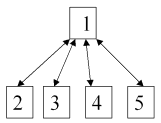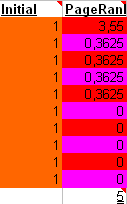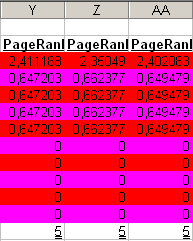The Spreadsheet - a simple structure
 Consider the simple set-up to the left. This structure is already typed into the spreadsheet.
Consider the simple set-up to the left. This structure is already typed into the spreadsheet.
Page1 links to Page2, 3, 4 and 5 - and they all link back to Page1. The set-up is entered like shown below:

|
| How to specify the simple structure |

|
| The first iteration |
Page1 has 4 other pages linking to it - so it gets a high PageRank in the first iteration.
Each of the pages 2, 3, 4 and 5 has only one inbound link, namely Page1. So each of them get only a quarter of Page1's initial PageRank - plus a little damping (see the description of the the formula).
Notice that the sum of the Page Ranks is 5 - so the average is 1.

|
| The second iteration |

|
| The values converge |
The results are oscillating - but if you make more iterations, you'll see that the results get closer and closer to a final value - as shown at the right.
Try altering the spreadsheet by making more internal links or adding more pages - and see how the PageRank distributes.
The simple structure concentrates PageRank on the home page more than any other structure does. Page1 has a PageRank that is almost half the site's total PageRank. For each new page that is added to the site, Page1's PageRank will grow by a value close to 0.5(1) whereas the PageRank of the existing sub-pages will drop slightly, because Page1 now must feed more sub-pages.
Next: The pyramid structure.